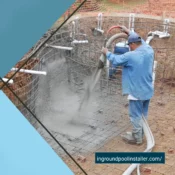Preparing Your Yard: A Guide to Inground Pool Excavation

Preparing Your Yard: A Guide to Inground Pool Excavation
Embarking on the journey of inground pool installation requires a meticulous approach to yard preparation, with a focus on zoning compliance and site readiness. Before any excavation begins, securing the appropriate permits is paramount, ensuring adherence to local regulations. Essential steps include thorough site clearing and grading to establish optimal drainage and mitigate potential settling complications. Conducting comprehensive soil tests is critical to evaluate the soil's load-bearing capacity, directly impacting structural integrity. Furthermore, pinpointing underground utilities and instituting erosion control measures are vital components of a successful excavation. What other factors must one consider to seamlessly transition from planning to execution?
Understanding Zoning and Permits
An essential preliminary step in the process of inground pool excavation is comprehending the intricacies of zoning laws and permit requirements. These regulations ensure that construction projects adhere to community standards and safety protocols, thereby fostering a sense of order and harmony within the neighborhood.
Zoning laws dictate the permissible uses of land and outline restrictions such as setbacks from property lines and structures, which must be meticulously adhered to during the planning phase. Understanding these stipulations is crucial to avoid the costly repercussions of non-compliance, including fines or mandated removal of improperly sited structures.
Permit acquisition is another vital component, necessitating a thorough review of local governmental requirements. Typically, this involves submitting detailed plans and specifications for the proposed pool, including its dimensions, location, and construction methods. This process may require coordination with multiple municipal departments and adherence to specific timelines for approval.
The complexity of these procedures underscores the need for engaging with knowledgeable professionals who can navigate the regulatory landscape effectively. By ensuring compliance with zoning and permit requirements, homeowners contribute to maintaining the aesthetic and functional integrity of their community, cultivating a shared environment where safety and neighborly respect prevail.
Site Preparation and Soil Testing
Site preparation and soil testing are critical phases in the inground pool excavation process, serving as the foundation for successful construction. These steps ensure that the pool is built on stable ground, minimizing potential issues such as settling or structural failure. Proper site preparation involves several key actions:
- Clearing and Grading: Begin by removing any existing vegetation, debris, or structures within the designated pool area. Properly grade the site to ensure optimal drainage and prevent water accumulation, which could undermine the pool's integrity.
- Soil Testing: Conduct comprehensive soil analysis to determine soil composition, load-bearing capacity, and moisture content. This information guides the selection of appropriate construction techniques and materials, especially if the soil has high clay content or is prone to shifting.
- Utilities Identification: Identify and mark existing underground utilities, including gas, water, and electrical lines, to avoid accidental damage during excavation. This step is crucial for safety and compliance with local regulations.
- Erosion Control Measures: Implement erosion control strategies such as silt fences or sediment basins to protect surrounding areas from soil displacement during construction. These measures maintain site stability and prevent environmental damage.
Coincidentally, the intricacies of preparing a yard for inground pool excavation reveal the importance of meticulous planning and adherence to regulations. Compliance with zoning laws and permit acquisition, alongside comprehensive site preparation and soil testing, forms the foundation of a successful project. The identification of underground utilities and implementation of erosion control measures further ensure structural integrity. Remarkably, this convergence of procedures underscores the necessity for precision and foresight in creating a durable and sustainable inground pool environment.
All Categories
- Concrete
- Concrete
- Concrete pools
- Construction
- Custom Features and Add-ons
- Design
- Design
- Design
- Design & Construction
- Design and Planning
- Features & Customization
- Infinity edge
- inground pool
- inground pool builder
- inground pool installer
- Installation
- Installation Process
- Legal & Administrative
- Materials
- planning and design
- Pool Aesthetics and Customization
- Pool Design
- Pool Equipment
- Pool Features
- Pool Features
- Pool Installation Process
- Pool Materials
- Pool Materials
- Pool Types
- Project Planning
- Renovation
- Resurfacing
- top sights
- Types of Inground Pools
- Types of Inground Pools
- Types of Inground Pools
- Types of Inground Pools
- Water Treatment



